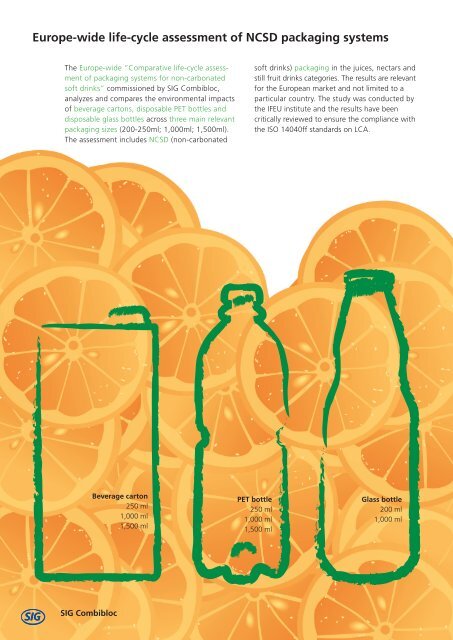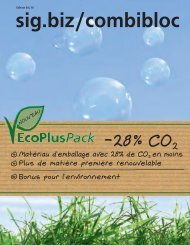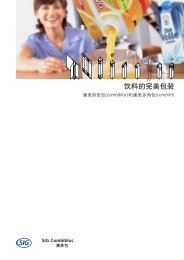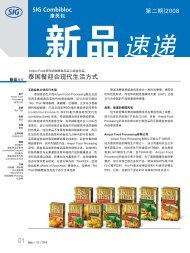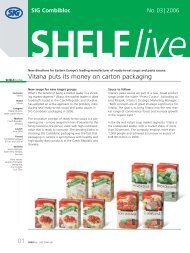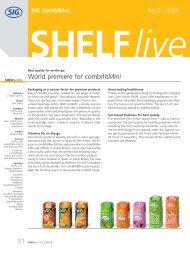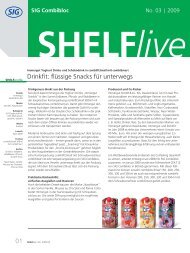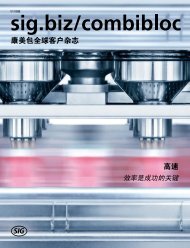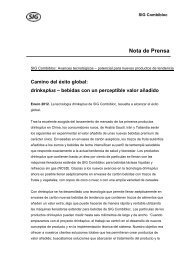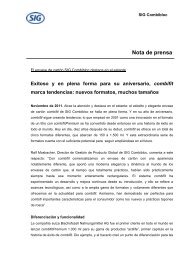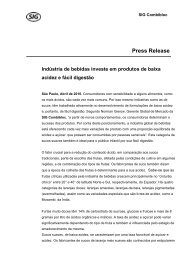Europe-wide life-cycle assessment of NCSD packaging systems
Europe-wide life-cycle assessment of NCSD packaging systems
Europe-wide life-cycle assessment of NCSD packaging systems
Create successful ePaper yourself
Turn your PDF publications into a flip-book with our unique Google optimized e-Paper software.
<strong>Europe</strong>-<strong>wide</strong> <strong>life</strong>-<strong>cycle</strong> <strong>assessment</strong> <strong>of</strong> <strong>NCSD</strong> <strong>packaging</strong> <strong>systems</strong><br />
The <strong>Europe</strong>-<strong>wide</strong> “Comparative <strong>life</strong>-<strong>cycle</strong> <strong>assessment</strong><br />
<strong>of</strong> <strong>packaging</strong> <strong>systems</strong> for non-carbonated<br />
s<strong>of</strong>t drinks” commissioned by SIG Combibloc,<br />
analyzes and compares the environmental impacts<br />
<strong>of</strong> beverage cartons, disposable PET bottles and<br />
disposable glass bottles across three main relevant<br />
<strong>packaging</strong> sizes (200-250ml; 1,000ml; 1,500ml).<br />
The <strong>assessment</strong> includes <strong>NCSD</strong> (non-carbonated<br />
Beverage carton<br />
250 ml<br />
1,000 ml<br />
1,500 ml<br />
s<strong>of</strong>t drinks) <strong>packaging</strong> in the juices, nectars and<br />
still fruit drinks categories. The results are relevant<br />
for the <strong>Europe</strong>an market and not limited to a<br />
particular country. The study was conducted by<br />
the IFEU institute and the results have been<br />
critically reviewed to ensure the compliance with<br />
the ISO 14040ff standards on LCA.<br />
PET bottle<br />
250 ml<br />
1,000 ml<br />
1,500 ml<br />
Glass bottle<br />
200 ml<br />
1,000 ml
<strong>Europe</strong>-<strong>wide</strong> <strong>life</strong>-<strong>cycle</strong> <strong>assessment</strong> <strong>of</strong> <strong>NCSD</strong> <strong>packaging</strong> <strong>systems</strong><br />
This <strong>life</strong>-<strong>cycle</strong> <strong>assessment</strong> (LCA) evaluates the entire <strong>life</strong> <strong>cycle</strong> <strong>of</strong><br />
<strong>NCSD</strong> <strong>packaging</strong> taking into account all relevant environmental<br />
impact categories – beginning with the extraction and refining<br />
<strong>of</strong> the raw materials, to the manufacture <strong>of</strong> the <strong>packaging</strong>, the<br />
transportation, the filling process, distribution to the retailing<br />
stage and right up to disposal or recycling after use. Not included<br />
are the filling goods, shopping and use phases as these are<br />
assumed to be equal for each <strong>packaging</strong> system. The study was<br />
also critically reviewed and verified by an independent panel <strong>of</strong><br />
experts.<br />
ISO 14040ff compliant and critically reviewed<br />
LCA is an important environmental tool for companies to<br />
furnish credible pro<strong>of</strong> <strong>of</strong> their environmental responsibility<br />
to different stakeholders<br />
LCAs are the only tool for environmental <strong>assessment</strong><br />
being standardized world<strong>wide</strong> according to binding<br />
ISO 14040ff standards<br />
Institute for Energy and Environmental Research (IFEU)<br />
The independent IFEU institute based in Heidelberg, Germany,<br />
is one <strong>of</strong> the most reputable environmental research institutes in<br />
<strong>Europe</strong>, with extensive industry knowledge due to several LCAs<br />
on the environmental performance <strong>of</strong> the PET bottle, the beverage<br />
can and the beverage carton.<br />
Results:<br />
Primary raw material as key driver <strong>of</strong> environmental<br />
performance<br />
Type <strong>of</strong> raw material and quantity are the decisive factors<br />
with regard to environmental impact<br />
Beverage carton with better environmental<br />
performance in most impact categories<br />
Across all sizes, the beverage carton performs significantly<br />
better in the key impact categories “climate change” (up to<br />
64% against PET) and “fossil resource consumption” (up to<br />
75% against PET). This is because wood has a carbon neutral<br />
balance and the cardboard is produced with a high level <strong>of</strong><br />
renewable energy (>90%)<br />
Manufactured mainly from pulp fibres obtained from wood,<br />
a renewable resource, carton packs consequently show<br />
the highest impact in the “use <strong>of</strong> nature” category. But in<br />
con trast to finite resources, a constant supply <strong>of</strong> this raw<br />
material is possible: Having 100% <strong>of</strong> its cardboard suppliers,<br />
its converting sites and sales <strong>of</strong>fices FSC Chain <strong>of</strong> Custody -<br />
certified, SIG Combibloc can prove that 100% <strong>of</strong> the wood<br />
fibres used to produce the carton packs are from controlled<br />
or FSC-certified sources<br />
The results show that carton packs perform better in the key<br />
impact categories even when assuming a notional but not<br />
yet realistic average re<strong>cycle</strong>d PET share <strong>of</strong> 50%. Furthermore,<br />
carton packs show a significant potential for a further 20%<br />
reduction <strong>of</strong> CO 2 emissions using a new carton structure<br />
which is under development<br />
Overview LCA results<br />
Beverage carton vs.<br />
PET bottle<br />
Fossil resource<br />
consumption<br />
(in kg crude oil equivalent)*<br />
Non-renewable<br />
primary energy<br />
(in giga joule)*<br />
Total primary energy<br />
consumption<br />
(in giga joule)*<br />
Use <strong>of</strong> nature<br />
(in m2 )*<br />
Climate change<br />
(in kg CO equivalent)*<br />
2<br />
Acidification<br />
(in g SO equivalent)*<br />
2<br />
Eutrophication<br />
(in g PO equivalent)*<br />
4<br />
Human toxicity PM10 (in g PM equivalent)*<br />
10<br />
Fossil resource consumption (medium size)<br />
(in kg crude oil equivalent; per <strong>packaging</strong> required for <strong>packaging</strong><br />
1000 L non-carbonated s<strong>of</strong>t drinks)<br />
20.58 42.18 49.91 65.07<br />
-68 %<br />
-59 %<br />
-51 %<br />
carton significantly better<br />
no significant difference<br />
carton significantly „worse“ 1<br />
Small size Medium size Large size<br />
-75% -51% -47%<br />
-70% -42% -35%<br />
-61% -24% -14%<br />
+65% +93% +85%<br />
-64% -28% -18%<br />
-54% -13% -1,3%<br />
-56% +/-0% +5%<br />
-57% -15% -7%<br />
* per <strong>packaging</strong> required for 1,000 L non-carbonated s<strong>of</strong>t drinks<br />
1 at a 10% significance level<br />
Monolayer Multilayer<br />
Beverage carton PET bottle Glass bottle<br />
Climate change (medium size)<br />
(in kg CO equivalent; per <strong>packaging</strong> required for <strong>packaging</strong><br />
2<br />
1000 L non-carbonated s<strong>of</strong>t drinks)<br />
87.72 121.18 144.67 295.25<br />
-70 %<br />
-39 %<br />
-28 %<br />
Beverage carton<br />
Monolayer Multilayer<br />
PET bottle Glass bottle<br />
Resource-related<br />
impact categories<br />
Emission-related<br />
impact categories


